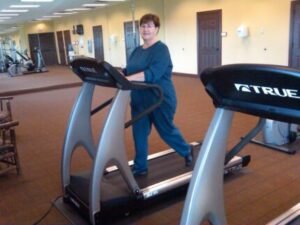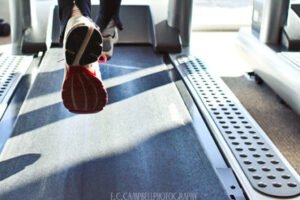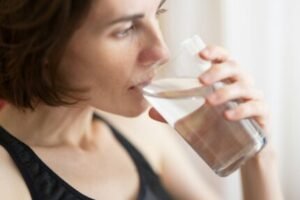Medically reviewed by Dr. Ramesh Gaddam, M.D. — Written by Sumalatha, D.N.H.E
Table of Contents
ToggleThe treadmill is great for beginners because it provides a safe place to exercise, no matter the weather or how busy you are.
Whether you want to get healthier, lose weight, or just feel fitter, you can customize your treadmill workout to fit what you want to achieve.
Follow these easy steps to build stamina, burn calories, and feel great while using the treadmill.
1. Start with Warm-up (5 minutes)
Begin your treadmill session with a thorough warm-up to prepare your body for exercise.

Brisk Walking
Initiate the warm-up phase by stepping onto the treadmill and setting the speed to a comfortable pace.
Aim for a brisk walk, maintaining a steady rhythm with each step.
Gradual Heart Rate Increase
As you walk, focus on your breathing and allow your body to adjust gradually to the increased activity.
The goal is to elevate your heart rate gradually, signaling your cardiovascular system to prepare for exercise.
Posture and Movement
Concentrate on maintaining good posture throughout the warm-up.
Keep your shoulders relaxed and your core engaged.
Allow your arms to swing naturally by your sides to promote circulation and loosen up your upper body.
Benefits of Warm-up
This phase serves two main purposes: raising your body temperature and priming your muscles for more intense activity.
By walking briskly, you stimulate blood flow to your muscles, increasing flexibility and reducing the risk of injury during the main workout.
Listening to Your Body
Pay attention to how your body feels during the warm-up.
It should feel challenging enough to get your blood flowing but comfortable enough to sustain for the duration.
Setting the Tone
Remember, the warm-up sets the tone for your entire workout.
Taking the time to properly prepare your body will enhance performance and help prevent injury.
Take this opportunity to ease into your treadmill session and set yourself up for success.
2. Interval Training (15-20 minutes)
Add interval training into your treadmill workout to boost endurance and calorie burn.

Alternate Walking and Jogging/Running
Switch between walking and jogging or running to vary the intensity of your workout and challenge your body.
Walk (1-2 minutes):
Begin with a comfortable walking pace to recover and catch your breath after the warm-up.
Jog/Run (1 minute):
Increase the speed to a jogging or running pace for a burst of higher intensity.
Repeat Cycle:
Continue alternating between walking and jogging/running intervals for the duration of the workout, aiming for a total of 15-20 minutes.
Progressive Approach
As you become more accustomed to interval training, consider adjusting the duration of your jogging/running intervals and decreasing the walking intervals to increase the challenge and intensity of your workout.
Gradual Progression
Gradually increase the duration of your jogging/running intervals and decrease the walking intervals as you progress in your fitness journey.
This incremental approach will help improve endurance and stamina over time.
Listen to Your Body
Pay attention to how your body responds to the intervals.
If you feel fatigued or overly strained, adjust the intensity or duration of the intervals accordingly to avoid injury.
Benefits of Interval Training
Interval training is an effective way to improve cardiovascular fitness, burn calories, and enhance overall endurance.
Incorporating intervals into your treadmill workout adds variety and keeps your routine engaging and challenging.
3. Cool-down (5 minutes)
Wrap up your treadmill workout with a proper cool-down to gradually lower your heart rate and prevent muscle soreness.

Decrease Speed to a Slow Walk
Reduce the treadmill speed to a gentle, slow walk.
This gradual decrease in intensity allows your body to transition smoothly from the workout phase to a state of rest.
Lowering Heart Rate
As you walk at a slower pace, focus on deep breathing to help regulate your heart rate and promote relaxation.
This gradual reduction in heart rate prevents abrupt changes that can lead to dizziness or discomfort.
Stretching
Utilize the cool-down period to stretch your muscles, targeting key areas such as your legs, back, and shoulders.
Perform each stretch slowly and hold for 15-30 seconds to improve flexibility and alleviate tension.
Leg Stretches:
Quadriceps Stretch:
Stand tall and bring one heel towards your glutes, holding onto your foot or ankle with your hand.
Hamstring Stretch:
Sit on the floor with one leg extended and the other bent. Lean forward from your hips, reaching towards your toes.
Back Stretches:
Cat-Cow Stretch: Begin on your hands and knees. Arch your back upwards (cat pose), then lower your belly and lift your chest (cow pose).
Shoulder Stretches:
Shoulder Stretch: Extend one arm across your body at shoulder height and gently press it towards your chest with your other hand.
Benefits of Cool-down
A proper cool-down helps prevent muscle stiffness and soreness by promoting blood flow and aiding in the removal of metabolic waste products from your muscles.
It also promotes relaxation and helps to gradually return your body to its pre-exercise state.
Takeaway
Incorporate a thorough cool-down into your treadmill routine to optimize recovery and minimize post-workout discomfort.
By gradually reducing intensity and stretching your muscles, you’ll enhance flexibility, improve recovery, and set the stage for future workouts.
4. Strength and Flexibility Exercises (optional)
Enhance your treadmill workout by integrating strength and flexibility exercises to build muscle and improve overall fitness.

Body-weight Exercises
Incorporate body-weight exercises such as lunges, squats, and calf raises to target major muscle groups and improve strength.
Perform these exercises on or beside the treadmill between intervals or during cool-down periods.
Lunges:
Step forward with one leg and lower your body until both knees are bent at a 90-degree angle. Alternate legs for a balanced workout.
Squats:
Stand with feet shoulder-width apart and lower your body as if sitting back into a chair, keeping your chest upright and knees behind toes.
Calf Raises:
Rise onto your toes, lifting your heels off the ground, then lower back down to complete one repetition.
Treadmill Incline Walking
Utilize the incline feature of the treadmill to engage different muscle groups and increase the intensity of your workout.
Incline walking targets the glutes, hamstrings, and calves while also providing cardiovascular benefits.
Incline Walking: Increase the treadmill’s incline to simulate uphill terrain.
Maintain a steady pace while walking, focusing on engaging your lower body muscles.
Flexibility Training
Incorporate stretching exercises to improve flexibility and range of motion, reducing the risk of injury and promoting muscle recovery.
Dynamic Stretching:
Perform dynamic stretches such as leg swings, arm circles, and torso twists to warm up muscles and joints before exercising.
Static Stretching:
Hold static stretches for major muscle groups, including quadriceps, hamstrings, calves, and upper body muscles, during cooldown periods to improve flexibility and reduce muscle tension.
Benefits of Strength and Flexibility Training
Adding strength and flexibility exercises to your treadmill workout enhances overall fitness by targeting muscle strength, endurance, and flexibility.
This comprehensive approach helps prevent injuries, improves posture, and enhances athletic performance.
Personalization and Progression
Customize your strength and flexibility routine to suit your fitness level and goals.
Increase the intensity of exercises by adding resistance or increasing the duration and frequency of workouts as you progress.
Integrating strength and flexibility exercises into your treadmill routine offers a balanced approach to fitness, improving strength, flexibility, and overall health.
5. Hydration and Recovery
Maintaining proper hydration and allowing adequate recovery time are essential components of a successful treadmill workout regimen.
Stay Hydrated
Ensure you’re adequately hydrated by drinking water before, during, and after your treadmill session.
Hydration is crucial for regulating body temperature, lubricating joints, and transporting nutrients to cells.
Pre-Workout Hydration:
Drink water at least 30 minutes before your treadmill workout to ensure your body is adequately hydrated.
During Workout Hydration:
Sip water throughout your workout to replenish fluids lost through sweat and maintain hydration levels.
Post-Workout Hydration:
Drink water immediately after your treadmill session to rehydrate and support muscle recovery.
Recovery Time
Allow your body sufficient time to recover between treadmill workouts. Rest and recovery are essential for muscle repair, glycogen replenishment, and overall recovery.
Rest Days:
Schedule at least one day of rest or low-impact activity between treadmill sessions to allow your muscles to recover and rebuild.
Low-Impact Activities:
On rest days, engage in activities such as walking, swimming, or yoga to promote blood flow, flexibility, and recovery without placing excessive strain on muscles.
Importance of Hydration and Recovery
Proper hydration supports optimal performance, endurance, and recovery during treadmill workouts.
Adequate rest between workouts helps prevent over training, reduces the risk of injury, and allows your body to adapt and improve over time.
Listen to Your Body
Pay attention to signs of dehydration or overexertion during your treadmill workouts.
Symptoms such as excessive thirst, fatigue, dizziness, or muscle cramps may indicate the need for more fluids or additional rest.
Personalized Approach
Adjust your hydration and recovery strategies based on factors such as exercise intensity, duration, environmental conditions, and individual hydration needs.
Conclusion
Prioritize hydration and recovery as integral parts of your treadmill workout routine.
By staying hydrated and allowing adequate time for rest and recovery, you’ll optimize performance, reduce the risk of injury, and support long-term fitness goals.
6. Progression
As your fitness level improves, it’s essential to progressively challenge yourself during treadmill workouts to continue seeing results and prevent plateaus.

Here’s how you can effectively progress your treadmill routine:
Gradual Intensity Increase
Gradually increase the intensity of your treadmill workouts by adjusting various factors such as speed, incline, or duration of intervals.
Start with small increments to avoid overexertion and allow your body to adapt gradually.
Speed Adjustment
Increase the treadmill speed to challenge your cardiovascular system and improve your running or walking pace.
Aim to run or walk at a slightly faster pace than your previous workouts while maintaining good form and control.
Incline Variation
Incorporate incline training into your treadmill routine to simulate uphill terrain and engage different muscle groups.
Gradually increase the incline level to intensify your workout and boost calorie burn.
Interval Duration
Extend the duration of your intervals by increasing the length of time you spend jogging or running and reducing the rest periods.
This helps improve endurance and stamina over time.
Listen to Your Body
Pay attention to how your body responds to increased intensity during treadmill workouts.
If you experience excessive fatigue, shortness of breath, or discomfort, dial back the intensity and progress more gradually to avoid injury.
Consultation
Before making significant changes to your exercise routine or increasing intensity, consult with a healthcare professional, especially if you have underlying health conditions or concerns.
They can provide personalized advice and ensure you’re progressing safely.
Self-Awareness and Adjustment
Listen to your body’s signals and adjust your workouts accordingly.
If you feel overly fatigued or experience persistent pain or discomfort, it’s essential to rest and modify your routine as needed to prevent injury.
Conclusion
Progression is key to improving fitness and achieving your goals with treadmill workouts.
By gradually increasing intensity while listening to your body and seeking guidance when necessary, you can safely and effectively enhance your treadmill routine for long-term success.
Things Required for Treadmill Workouts
To effectively engage in treadmill workouts, several items are essential to ensure comfort, safety, and optimal performance:
Treadmill:
The primary equipment for treadmill workouts is, of course, the treadmill itself.
Whether it’s at a gym or in your home, make sure the treadmill is in good working condition and suits your fitness needs.
Buy on Walmart: Click Here
| Check Out Best Treadmills ⇒ |
Proper Footwear:
Invest in a pair of supportive and comfortable athletic shoes designed for running or walking.
Proper footwear helps prevent injuries and provides adequate cushioning and support for your feet.
| Checkout Best Foot wear ⇒ |
Water Bottle:
Stay hydrated during your workout by keeping a water bottle within reach.
Hydration is essential for maintaining performance and preventing dehydration.
Towel:
Have a towel nearby to wipe away sweat and keep yourself comfortable during your workout.
Workout Attire:
Wear moisture-wicking and breathable clothing suitable for exercise.
Choose lightweight fabrics that allow for freedom of movement and help regulate body temperature.
Heart Rate Monitor (Optional):
Consider using a heart rate monitor to track your heart rate and monitor workout intensity.
This can help you stay within your target heart rate zone for optimal cardio-respiratory benefits.
⇒Checkout Best Heart Rate Monitor⇐
Safety Key (if applicable):
Some treadmills come with a safety key that attaches to your clothing and automatically stops the treadmill if you fall or drift too far back.
Make sure to use this feature if your treadmill includes it.
Music or Entertainment:
Create a motivating workout playlist or prepare your favorite entertainment to keep yourself engaged and motivated during your treadmill session.
Cooling Fan (Optional):
If your treadmill has a built-in cooling fan or you have a portable fan, use it to stay cool and comfortable during your workout.
Exercise Mat (Optional):
Place an exercise mat under your treadmill to protect your flooring and reduce noise if you’re using it in a home gym setting.
By having these essential items ready, you can ensure a safe, comfortable, and effective treadmill workout experience.
Medically reviewed by Dr. Ramesh Gaddam, M.D.

General Physician, Diabetologist, and Critical Care Specialist.
Related
Discover more from Health Build-Up
Subscribe to get the latest posts sent to your email.


1 thought on “7 Best Treadmill Workout Tips for Beginners (2024)”
Comments are closed.